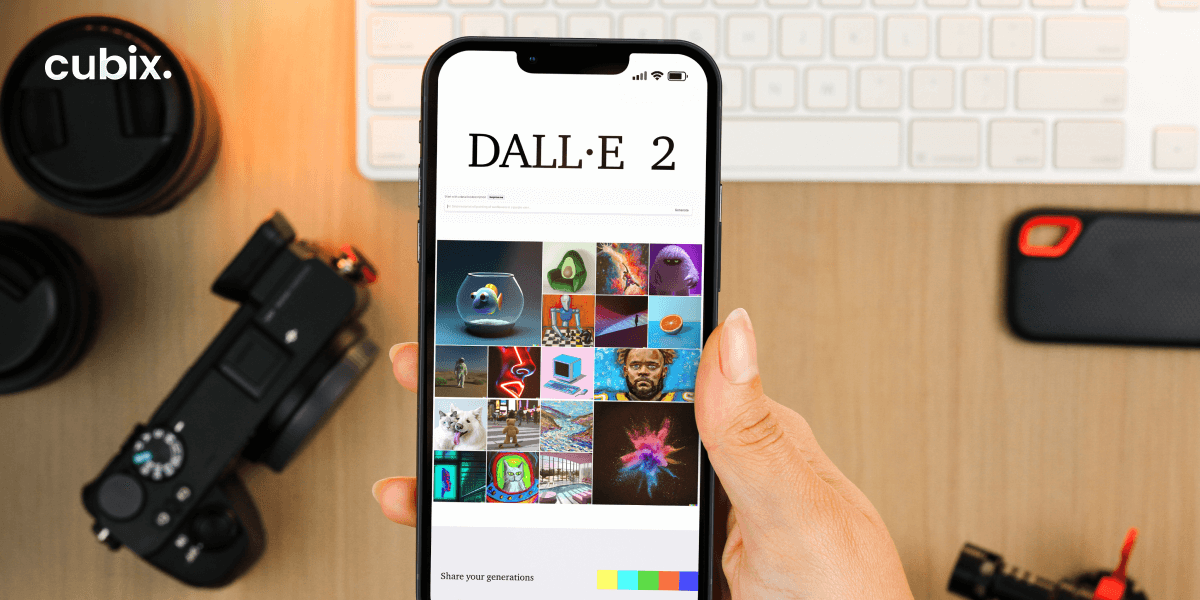The world has changed, again. But this is a paradigm shift in action, still taking place as we follow it.
We’ve all likely heard about OpenAI’s algorithm and its fantastic models like GPTChat, DALL-E, DALL -2, and CODEX, among others, each with potent capabilities that are geared to serve us tomorrow.
The extent of the algorithm’s capabilities already has Google on amber alert since it now feels challenged at the hands of ChatGPT, an advanced chat component that (although far short of being perfect) is fast and delivers unprecedented intelligent answers as solutions, including articles, research papers, and more.
While the objectivity and accuracy of the end result are debatable, its speed and volume are both astounding.
No less than ChatGPT is the magnificent DALL-E, an AI-based language model from OpenAI that produces lifelike visuals from various entities' textual and imagery characterization. The Spanish artist Salvador Dali's name and the animated robot character Wall-E from Pixar's movie of the same name was the inspiration for OpenAI's neural network. Shortly, due to its unprecedented, innovative approach, it took the world by storm.
The latest DALL-E upgrade, DALL-E 2, was just released by OpenAI. It is a more durable and robust phenomenological system that can produce artwork with a high level of visualization.
In addition, DALL-E 2 enables users to modify a produced image simply by providing written directions, such as “replace that dated stool with a plush armchair" or “reduce the height of famous buildings.” It also has improved definition, quick rendering, and an editing option. Even better, users may upload their artwork and give the AI system instructions to obtain their desired outcomes.
What is DALL-E 2?
DALL-E 2 is an artificial intelligence model that creates and recreates visuals using text prompts likely to even satisfy a vivid imagination. As a new and improved successor of DALL-E, DALL-E 2 can grasp human texts, relate them to preexisting ideas, and create unique visualizations faster and more efficiently.
DALL-E 2 employs a method known as "diffusion," which selects a sequence of freely positioned dots, and alters the sequence as it starts picking up on aspects of that image to imitate a visual. As a result, DALL-E 2 generates four different variants from which you can choose.
How do I access DALL-E 2?
Although DALL-E 2 started as a research project, it is now available through an API for users to access and utilize for their projects. But first, you must register an account if you want to use DALL-E 2 immediately without any hassle.
In the beginning, everyone gets 50 free credits, which is more than enough to help you explore how the tool works. After that, you get another 15 free credits each month. But they don't go very far. So, if you want to use the tool regularly, you'll eventually need to pay a fee.
You can utilize the stunning DALL-E 2 once you fulfill the sign-up process. First, in the text field, type a statement of what you desire, such as "a cobbler fixing an alien shoe." Then press the 'generate' button; DALL-E 2 will generate four unique 1024x1024 visuals that reflect what you stated.
You can visit the OpenAI website to see some stunning examples of DALL-E usage and DALL-E 2 examples that let you experience the difference between the two and observe the improvements OpenAI has accomplished with DALL-E 2 in a short period.
See More: Hire Our Artificial Intelligence Development Company for Your Project
How DALL-E 2 Works
After logging in, you can compose a text prompt or upload a photo to edit on the main page. The text prompt produces four illustrations. Users may now save and download their favorite shots.
The various approaches DALL-E 2 offers for producing a visual include textual prompts, variants, and edits. Text prompts are human language portrayals of the images, while variants are made from already prepared or submitted visuals.
Edits allow you to produce incredible adjustments in a visual. You have further influence over a visual in advance of text prompts and variants. For example, you may adjust the geographical area or environment, upload customized photographs, and remove or eradicate any characteristics you don't desire
Other DALL-E 2 use cases, like out-painting capability, also let you increase an image's landscape. As DALL-E 2 only produces square format pictures (1024 × 1024 pixels in size), out-painting can aid in altering the image's size by making it broader or narrower.
Typing an instruction to generate an image that you desire is a generalized basis. You must know more about this to achieve the best outcomes. You ought to feed an instruction based on what you visualize or depict.
While you may do that as accurately as you can, it is surely possible that images produced by DALL-E 2 might not live up to your expectations. Therefore, it's crucial to communicate your preferences to DALL-E 2. Again, image variations increase the likelihood of obtaining the intended result.
One way to obtain a more accurate result is to indicate the kind of image you need (canvas, sketch, photograph, etc.), the genre (contemporary art, visual art, etc.), its relevant subject matter (people, creatures, products, etc.), terrain, and location.
You will get more accurate results from lengthy thorough descriptions than concise ones. DALL-E 2 will run its own interpretations if you leave some doubts open for it to address (such as about color, aesthetics, or dimensions).
By the way, here are some other standard terms that comprise the back-end process:
CLIP (Contrastive Language-Image Pre-training): Text/image embeddings are a type of model that takes matchups of images and captions and produces "intellectual" portrayals in the form of vectors.
Prior Model: Creates CLIP visual embeddings using a caption or CLIP text embedding.
The Diffusion Model (unCLIP): Produces visuals using a CLIP image embedding.
DALL-E 2: Prior + diffusion decoder (unCLIP) model combo.
You must have gotten a fair idea of the concepts surrounding Dall-E2 by now. You will at least be in a position to offer an answer to anyone asking questions like, "What is DALL-E 2 and How does it Work?" However, let’s take a look at the working process of DALL-E 2 variants.
Read More: Potent Technologies in an Unprecedented World: Create an App Using OpenAI
DALL-E 2 Use Cases in Creating Variants?
As part of how it operates, DALL-E 2 generates 4-5 more visuals (variants) that it considers somewhat comparable. This is a terrific tactic to go inexorably toward your preferred results.
Generating New Visuals with the Help of Preexisting Artwork
You can input any picture as long as you have the right to use it. For example, you may submit a historical artwork in the public domain, such as the Mona Lisa, or illustrations from free stock image sources.
Making a Variant of Your Work
You may add your artwork and modify it if you're a composer. It's among DALL-E 2 use cases since it generates a set of visuals with identical characteristics; for instance, this may save time while filming crowd scenes. But keep in mind that OpenAI presently asserts copyright ownership for the variants produced.
How much does it Cost to Use DALL-E 2?
DALL-E 2, is it free? Unfortunately, not. Until July 2022, it was free, but OpenAI now operates on a credit system. New DALLE 2 users receive 50 free credits for creating, tweaking, or generating image variants.
Following that, customers will receive 15 free DALL-E 2 credits every month. You must purchase them at the cost of $15 for 115 credits in order to obtain more (enough to generate 460 1024 X 1024-pixel images). Artists that require monetary assistance are encouraged to apply for discounted access through OpenAI.
There are a few important aspects to consider regarding credits:
Read More: How will AI-Artificial Intelligence Revolutionize the Future of Game Development?
DALL-E 2 for Commercial Use:
Who owns the AI-produced art is a key question that users may have. The answer is a tad complicated. It's a common myth that DALL-E 2 is artistically competent and surpasses human artistic ability. Still, the DALL-E 2 algorithm cannot produce visuals on its own as it needs creativity, aptitude, and intentionality in human language statements.
Users of DALL-E 2 are permitted to utilize the produced photos for business-related activities, including printing, trading, or licensing. The watermark in the corner of the image serves as a source credit requirement for users.
DALL-E 2 Limitations and Flaws
Despite all of DALL-E 2's upsides, the pictures from AI-based neural networks still have a lot to discover about the universe. The three most noticeable and intriguing DALL-E 2 examples regarding its flaws are listed below.
Text-Related Flaws:
Given how good it is at understanding the text prompts it employs to create images, it is amusing that DALL-E 2 fails to include meaningful text in its visuals. However, customers have found that when they request any type of text, they typically receive a jumbled collection of letters.
Science-Related Flaws:
Given that it is so simple to portray a spaceship coming from a hidden planet, one may argue that DALL-E 2 is aware of basic scientific principles. However, requesting an anatomical illustration, a statistical demonstration, or a design solving mathematical problems may appear to be correct on the superficial but are actually all erroneous.
Facial Recognition-Related Flaws:
When DALL-E 2 attempts to create realistic portraits of individuals, the faces occasionally turn into quite a mess. A further problem, though, is that the process is designed in a way that only has a single center of action for visuals.
Read More: Artificial Intelligence and its Impact on Businesses
What's Next for DALL-E 2?
Customers must always be captivated by fresh and intriguing visual content since the human mind is full of naturalistic visuals. DALL-E 2 makes it easy to generate new corporate looks, which is a growing, rich source for the creative marketing and branding sectors. In addition, DALL-E 2 makes it possible to replace generic stock portraits with interesting and compelling visual material.
Indeed, there’s a great deal more than can be added to what DALL-E 2’s future looks like. Much of the claims that the fraternity makes in advance are mere speculation. However, we have to wait and see what the future looks like with the promising technology driving these tools.
If someone asks you, "What is DALL-E 2?" you’re in a position to tell them a significant amount, and you’re already part of next-generation tech. You can put your efforts into creating a solution with OpenAI products or hand us the reins, and we'll do it the way you and the industry demand. Get in touch today!

